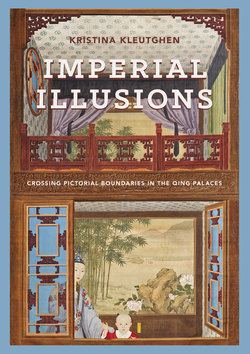Читать книгу Imperial Illusions - Kristina Kleutghen - Страница 17
На сайте Литреса книга снята с продажи.
Оглавлениеor bird’s-eye viewpoint that allowed the viewer to move visually through the depths of the entire depicted scene.11 The eighteenth-century Qing reappropriation of this term therefore prioritized native over foreign painting terminology, contextualizing firmly within Chinese tradition this type of painting that integrated Western techniques. Therefore, the translation of tongjinghua as “scenic illusion painting” aims to convey the illusionistic viewing experience inherent both in the Chinese term and in these particular paintings within their own unique cultural context of late imperial China.
The viewing experience for scenic illusion paintings comprised four phases: the imperial viewer’s initial deception by the pictorial illusion, his recognition of the reality of the painting, his identification of the significance of its subject matter, and finally his simultaneous appreciation of both the illusion and the painting as a single meaningful entity.12 As the viewer approached an installed scenic illusion, its deceptive, erasive style and wall- encompassing format supported the superficial illusion of reality by effacing the artists’ labor, thereby denying the work’s materiality and medium specificity. In the second phase, the composition of the painting (which was customized for the site), the particularity and significance of its architectural location and its logical imagery together buttressed the viewing experience. The painting was physically part of the real architectural space, and its subject matter was always absolutely appropriate for and even expected in that space. Only after recognition of the work as a painting cemented its materiality would the viewer reframe the experience as “viewing a painting” (albeit an unprecedented type of work) and evaluate the meaning of the subject matter. Ultimately, one enjoyed both the visual illusion and the knowledge that the work was a painting without one aspect weakening the other. As marvelous as the illusions were, the representational techniques supporting them made the paintings marvelous in themselves. The way that pictorial illusionism initially destroyed the materiality of the painting thereby redeemed itself, modulating any disappointment through the practical magic of the techniques and the revelation of the underlying meaning, which resituated both the work and the imperial viewer within more familiar cultural territory. This did not diminish the imperial viewing experience of scenic illusions, but rather enhanced it, and acknowledged the viewer’s superior refinement. Only a truly sophisticated viewer could simultaneously perceive and appreciate the illusion of space, objects, and figures alongside the meaningful reality of the painting as two aspects of a single experience (rather than two alternating experiences) without being troubled by such phenomenological doubleness.13
Scenic illusions therefore did something that traditional Chinese paintings did not: for an extended moment, the viewer had no sensory data that would support differentiating the painting from reality. In traditional Chinese paintings, typically portable works with distinctive ink brushwork that pointed to a recognizable artistic identity, the viewer’s world extended only up to the borders and the surface of the object. However, with scenic illusions that world continued seamlessly into the painting, creating a provocative alternative to the medium-specific nature of most viewing practices and the dominant
